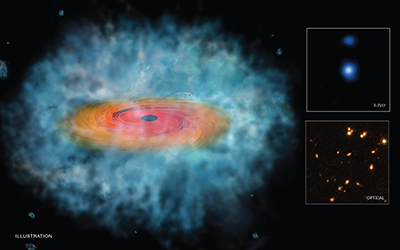Using data from three of NASA's Great Observatories (the Hubble Space Telescope, Chandra X-ray Observatory, and Spitzer Space Telescope), scientists have found the best evidence to date that supermassive black holes in the early universe were produced by the direct collapse of a gas cloud. If confirmed, this result could lead to new insight into how black holes were formed and grew billions of years ago. This artist's illustration depicts a possible "seed" for the formation of a supermassive black hole. The inset boxes contain Chandra (top) and Hubble (bottom) images of one of two candidate seeds, where the properties in the data matched those predicted by sophisticated models produced by researchers of the direct-collapse mechanism.

The team plans to obtain further observations in X-rays and the infrared to check whether these objects have more of the properties expected for black hole seeds. Upcoming observatories, such as NASA's James Webb Space Telescope and the European Extremely Large Telescope will aid in future studies by detecting the light from more distant and smaller black holes. Scientists currently are building the theoretical framework needed to interpret the upcoming data, with the aim of finding the first black holes in the universe.
For more information about this study, visit:
http://chandra.harvard.edu/press/16_releases/press_052416.html
